Related Research Articles

Stop motion is an animated filmmaking technique in which objects are physically manipulated in small increments between individually photographed frames so that they will appear to exhibit independent motion or change when the series of frames is played back. Any kind of object can thus be animated, but puppets with movable joints or plasticine figures are most commonly used. Puppets, models or clay figures built around an armature are used in model animation. Stop motion with live actors is often referred to as pixilation. Stop motion of flat materials such as paper, fabrics or photographs is usually called cutout animation.
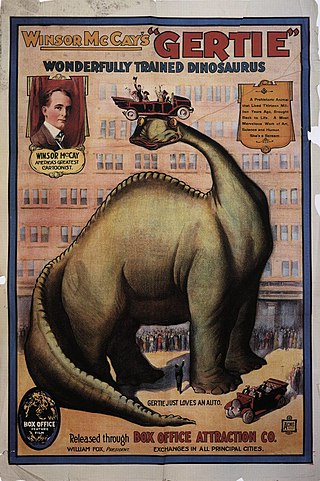
Gertie the Dinosaur is a 1914 animated short film by American cartoonist and animator Winsor McCay. It is the earliest animated film to feature a dinosaur. McCay first used the film before live audiences as an interactive part of his vaudeville act; the frisky, childlike Gertie did tricks at the command of her master. McCay's employer William Randolph Hearst curtailed McCay's vaudeville activities, so McCay added a live-action introductory sequence to the film for its theatrical release renamed Winsor McCay, the Famous Cartoonist, and Gertie. McCay abandoned a sequel, Gertie on Tour, after producing about a minute of footage.
The year 1908 in film involved some significant events.
While the history of animation began much earlier, this article is concerned with the development of the medium after the emergence of celluloid film in 1888, as produced for theatrical screenings, television and (non-interactive) home video.
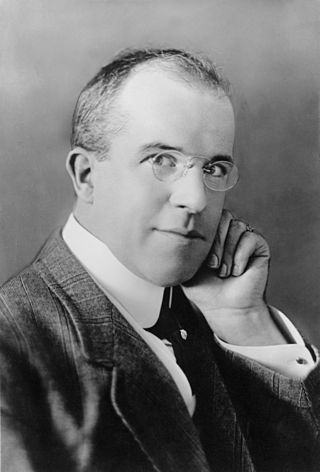
James Stuart Blackton was a British-American film producer and director of the silent era. One of the pioneers of motion pictures, he founded Vitagraph Studios in 1897. He was one of the first filmmakers to use the techniques of stop-motion and drawn animation, is considered a father of American animation, and was the first to bring many classic plays and books to the screen. Blackton was also the commodore of the Motorboat Club of America and the Atlantic Yacht Club.
The silent age of American animation dates back to at least 1906 when Vitagraph released Humorous Phases of Funny Faces. Although early animations were rudimentary, they rapidly became more sophisticated with such classics as Gertie the Dinosaur in 1914, Felix the Cat, Oswald the Lucky Rabbit, and Koko the Clown.
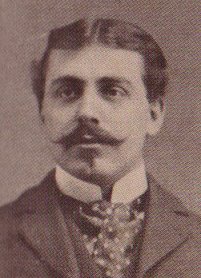
Vital Achille Raoul Barré was a Canadian cartoonist, animator of the silent film era, and painter. Initially known as a political cartoonist, he originated the French Canadian comic strip, then crossed over into animated film and started his own studio, a pioneering effort. As a painter, he is considered an Impressionist, evoking atmosphere and light with visible, choppy strokes of paint, whose paintings are in the Musée national des beaux-arts du Québec.

Grandma's Reading Glass is a 1900 British silent trick film, directed by George Albert Smith, featuring a young boy who borrows a huge magnifying glass to focus on various objects. The film was shot to demonstrate the new technique of close-up. According to Michael Brooke of BFI Screenonline, it "was one of the first films to cut between medium shot and point-of-view close-up." It was destroyed in a fire at Warwick Trading Company's studio facility in 1912 and was long thought lost. The film was discovered in 1960 in the collection of Danish court photographer and film pioneer Peter Elfelt.
Arthur Melbourne Cooper was a British photographer and early filmmaker best known for his pioneering work in stop-motion animation. He produced over three hundred films between 1896 and 1915, of which an estimated 36 were all or in part animated. These include Dreams of Toyland (1908) and according to some sources Dolly’s Toys (1901), as well as Matches: An Appeal, which Dutch independent researcher Tjitte de Vries has claimed may have been the first animated film to be shown in public.

In the early history of cinema, trick films were short silent films designed to feature innovative special effects.
Wallace McCutcheon Sr. was a pioneer cinematographer and director in the early American motion picture industry, working with the American Mutoscope & Biograph, Edison and American Star Film companies. McCutcheon's wealth of credits are often mixed up with the small handful of films directed by his son, Wallace McCutcheon Jr. (1884–1928).
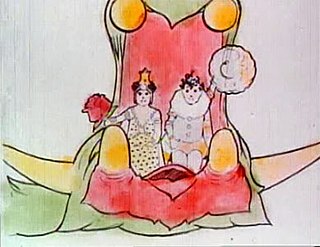
Winsor McCay: The Famous Cartoonist of the N.Y. Herald and His Moving Comics, more commonly known as Little Nemo, is a 1911 silent animated short film by American cartoonist Winsor McCay. One of the earliest animated films, it was McCay's first, and featured characters from McCay's comic strip Little Nemo in Slumberland. Its expressive character animation distinguished the film from the experiments of earlier animators.
The Humpty Dumpty Circus is a lost short stop-motion trick film directed by J. Stuart Blackton and Albert E. Smith, the Anglo-American founders of Vitagraph Studios. There are no known surviving copies.
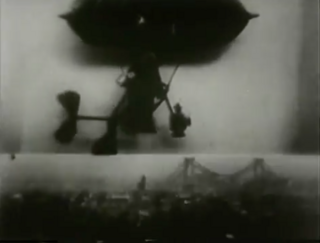
The Twentieth Century Tramp; or, Happy Hooligan and His Airship is an American silent short film produced and directed by Edwin S. Porter and released in 1902. This film is an adaptation of the cartoon Happy Hooligan, played by J. Stuart Blackton.

The 'Teddy' Bears is an American silent film directed by Edwin S. Porter and Wallace McCutcheon, and produced by the Edison Manufacturing Company starting as the fairy tale Goldilocks and ending as a political satire of United States President Theodore Roosevelt.
Events in 1904 in animation.
Dolly’s Toys was a 1901 British trick film, directed by Arthur Melbourne-Cooper. It may have used stop-motion animation, or a variant of the stop-action technique previously used by Walter R. Booth. Cooper would start producing animated films in 1904, starting with The Enchanted Toymaker.
Events in 1899 in animation.
Events in 1875 in animation.
Events in 1874 in animation.